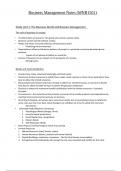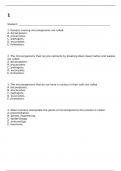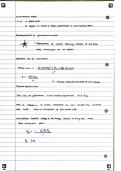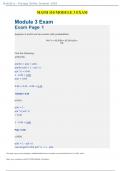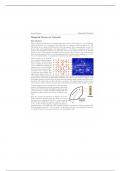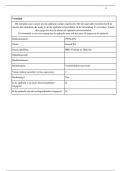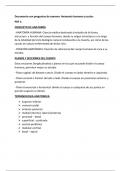Samenvatting zelfstudiebundel SPSS
De leerstof voor software Statistiek 1 wordt in het zwart aangegeven.
De leerstof voor software Statistiek 2 wordt in het blauw aangegeven.
, - Variable View
o Name: naam van de variabele (gebruik geen spaties)
o Type: gesloten vragen numeric, open vragen string
o Label: hele vraag of stelling invoeren
o Value labels: antwoordmogelijkheden bij gesloten antwoorden invullen
o Measure
Scale: kwantitatieve variabelen, interval- of ratioschaal
Ordinal: ordinale schaal
Nominal: categorische of nominale schaal
- Beschrijvende analyses uitvoeren voor aparte variabelen
o Analyze Descriptive statistics frequencies: frequentietabellen
o Analyze Descriptive statistics descriptives: beschrijvende grootheden
voor een kwantitatieve variabele (N, Min, Max, Gemiddelde, Stdev)
- Verschillen tussen groepen:
o Analyze Compare means means: gemiddelden van groepen op
bepaalde variabelen met elkaar vergeleken
Tot welke groep deelnemer behoort = independent list
Variabele waarvoor gemiddelden worden vergeleken = dependent list
Options Anova table and eta: aanvinken om te weten of verschil
significant is
Een verschil is significant als alfa < of = is aan 0.05
o Analyze Descriptives Crosstabs: inzicht over verbanden tussen 2
variabelen
Cells percentages: column: percentages berekenen per kolom
Statistics Chi-square: om te bepalen of de frequentieverdelingen
voor beide groepen significant verschillen
- Datamanipulaties voor verdere data-analyses
o Data select cases: focus op bepaalde groep
If condition is satisfied
= verschillend van
negatie (iets mag niet aanwezig zijn)
Maar handiger als je eerst een selectievariabele apart
aanmaakt via transform compute variable
o Transform recode into same variables: als je de bestaande variabele wilt
vervangen (beter deze optie niet gebruiken)
o Transform recode into different variables: als je de bestaande variabele
wilt behouden
o Transform Compute variable: nieuwe variabele berekenen gebaseerd op
een combinatie van andere variabelen
De leerstof voor software Statistiek 1 wordt in het zwart aangegeven.
De leerstof voor software Statistiek 2 wordt in het blauw aangegeven.
, - Variable View
o Name: naam van de variabele (gebruik geen spaties)
o Type: gesloten vragen numeric, open vragen string
o Label: hele vraag of stelling invoeren
o Value labels: antwoordmogelijkheden bij gesloten antwoorden invullen
o Measure
Scale: kwantitatieve variabelen, interval- of ratioschaal
Ordinal: ordinale schaal
Nominal: categorische of nominale schaal
- Beschrijvende analyses uitvoeren voor aparte variabelen
o Analyze Descriptive statistics frequencies: frequentietabellen
o Analyze Descriptive statistics descriptives: beschrijvende grootheden
voor een kwantitatieve variabele (N, Min, Max, Gemiddelde, Stdev)
- Verschillen tussen groepen:
o Analyze Compare means means: gemiddelden van groepen op
bepaalde variabelen met elkaar vergeleken
Tot welke groep deelnemer behoort = independent list
Variabele waarvoor gemiddelden worden vergeleken = dependent list
Options Anova table and eta: aanvinken om te weten of verschil
significant is
Een verschil is significant als alfa < of = is aan 0.05
o Analyze Descriptives Crosstabs: inzicht over verbanden tussen 2
variabelen
Cells percentages: column: percentages berekenen per kolom
Statistics Chi-square: om te bepalen of de frequentieverdelingen
voor beide groepen significant verschillen
- Datamanipulaties voor verdere data-analyses
o Data select cases: focus op bepaalde groep
If condition is satisfied
= verschillend van
negatie (iets mag niet aanwezig zijn)
Maar handiger als je eerst een selectievariabele apart
aanmaakt via transform compute variable
o Transform recode into same variables: als je de bestaande variabele wilt
vervangen (beter deze optie niet gebruiken)
o Transform recode into different variables: als je de bestaande variabele
wilt behouden
o Transform Compute variable: nieuwe variabele berekenen gebaseerd op
een combinatie van andere variabelen

